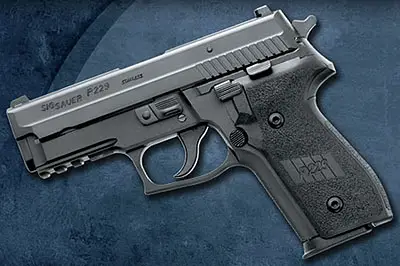|
SiG-Sauer P-229 .40 S&W Pistol By David Tong  Over the past year I have been evaluating many of the popular service semi-automatic pistols. For this review, I am visiting one of the SiG-Sauer products. The P-229 was the first of the Company's products to be built in the USA, starting back in 1993. It follows the P-Series template in that it is a double-action/single-action pistol (trigger cocking first shot, single-action for follow up shots). It is available in 9x19mm, .357 SiG and .40 S&W calibers; the test gun is chambered for the latter cartridge. Here are some basic specifications for the P-229 in .40 S&W.
While my primary carry piece is a 5� Kimber 1911, similar to what I have carried for over 25 years, the P-229 is unquestionably more comfortable in that it is both lighter and shorter. Typically, this also means that the pistol is more difficult to control in recoil and it has been my observation that .40 S&W is a bit harder to shoot rapidly and well than either 9mm or .45 ACP. The reasons for this are a bit complex. While a standard weight 180 grain JHP leaves the muzzle at a nominal 950 fps in .40 S&W, which is quite similar to the velocity of standard 185 grain .45 ACP ammunition, the .40 does have more muzzle blast due to its 34,000 psi maximum average pressure (MAP), which is nearly twice that of the .45 ACP. While the issue may be academic to many, the SiG P-series design has a rather high bore center, which increases the amount of muzzle flip and recovery time between shots. There are many plusses to the SiG P-Series design. It is quite simple to operate, using a �point and pull� trigger system and there is no worrisome external safety. It is similarly simple to field strip and clean. P-Series pistols typically have the best single action trigger pulls of the entire DA/SA genre and the test pistol�s pull weight is even lighter than the specified 4.4 pounds. It is crisp, with the usual take up and over travel endemic to the breed. However, SiG does offer both a short reach trigger (thinner blade) as well as an �SRT-short reset trigger� that decreases the length of the single-action trigger reset and enables a trained shooter to trigger the next shot a bit faster. Many shooters believe that the DA trigger is inherently safer than a SA semi-automatic, as it is not necessary to carry the piece �cocked and locked� to get it into action quickly and there is no need for a manual safety that can be fumbled. The DA to SA transition between first and second shots can be overcome with practice and, of course, the SiG's exposed hammer can be manually cocked for a SA first shot when desired. My take on it is that one has to be aware of the physiological changes the human body endures under stress, with adrenaline pumping and perhaps under poor light, and practice with your defense pistol a LOT. I think that the SiG system as exemplified by the P-229 is about as good as conventional DA autos get. The test pistol had the factory SiGlite tritium three dot sights installed, which glow brightly. Earlier SiG pistols had regular carbon steel slides and many users complained about rust when carrying concealed in humid climes. When SiG-Sauer moved production of the P-Series to the U.S., they decided to CNC-machine the slides out of stainless steel bar stock, and coat them with Nitron, a proprietary name for a matte black rust resistant surface coating. I believe that this pistol should shoot within a 3� circle at 25 yards. In the limited amount of shooting I was able to do, there were no malfunctions of any kind, although the CCI/Blazer 180 grain FMJ rounds I was shooting hit approximately 4� high at 25 yards. Were I to own this pistol and standardize on this ammunition, I would install a taller front sight to lower the point of impact. This would probably not be necessary with the higher performance, flatter shooting, 135-165 grain JHP ammo normally chosen for self-defense purposes. Besides a decent trigger, all P-Series pistols I�ve examined have a well-above average slide to frame and barrel to slide fit. Interior machining of the slide and its rails, the barrel channel and breechblock were good. It appears to me that the SiG is simpler, in terms of moving parts or parts count, than a Beretta 92 and more precisely manufactured than a Glock 17. Anecdotal reports suggest durability and reliability close to Glock�s impressive standard, with typically better accuracy than either of those pistols. Ergonomically, the grip width is a comfortable 1.5 inches, with the front frame strap being rather flat, necessary because of the double stack magazine. I was easily able to reach the trigger with the pad of my index finger with the pistol decocked, without twisting the pistol in my hand and bringing it out of line with the long axis of my forearm, thus ensuring good recoil support. In summation, for people who desire a double action first shot to reduce the likelihood of a negligent discharge and do not want an external safety to release before shooting, the P-229 offers a compact and relatively lightweight package packing a powerful cartridge. With a good trigger system and better than average accuracy, it is little wonder that more Federal agencies use the SiG P229 than any other pistol. |